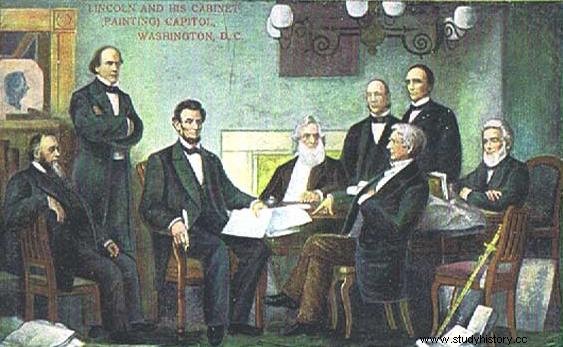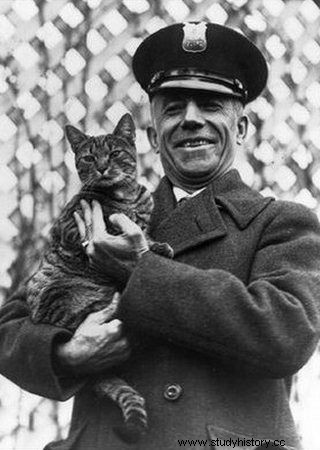The cat has absolute power in most home living rooms. What if the living room is the Oval Office of the White House? In the USA, the president's pet can cause an international scandal, and the cat star of TV commercials has the right to compete for a seat in the White House.
The history of America's favorite cats goes back to the early days of the president's office. Admittedly, George Washington himself was not a great enthusiast of these animals - he preferred horses and hounds - but Martha's wife kept several cats at the family estate in Mount Vernon.
For the next 60 years, dogs continued to reign in the White House, occasionally giving way to more exotic animals such as Thomas Jefferson's grizzly bears and the alligator given to John Quincy Adams by the Marquis de La Fayette. The reptile is said to have become the terror of visitors wishing to use the White House toilets.
The cat is smarter than the whole government
Abraham Lincoln turned out to be the first president to be a true lover of the cat species. The president was famous for his great love for animals - during his tenure in the White House you could meet several dogs, a goat, a pony and ... a turkey belonging to Lincoln's son, Tad. Among the animals there was also room for two cats, Tabby and Dixie, which Lincoln received from Secretary of State William Seward.

Although the first president of the United States, George Washington, did not like cats, his wife Martha did have several cats.
The president loved being with his pets. Marry Todd Lincoln claimed that cats had become her husband's hobby. Abraham himself used to say that "Dixie is smarter than my entire office! And what's more, he doesn't say back! ” . There is also the story of Taby who once interrupted an important dinner. He jumped forcefully onto the sumptuously set table, which embarrassed the First Lady. Lincoln himself said the whole situation as follows:
Since the golden forks were good enough for my predecessor, James Buchanan, I don't see why they shouldn't be as good for Tabby.

The first cat lover in the White House was Abraham Lincoln. In the picture together with his office. I wonder how many of these noble gentlemen also had cats?
The nineteenth president of the United States, Rutherford Hayes, in office in the years 1877–1881, went down in the history of, among others as the first owner of a Siamese cat in America. These cats, originating from Siam, which is today's Thailand, appeared in the White House thanks to the American consul in Bangkok, David B. Sickels.
The first Siamese was sent on a trip to America for over two months as a gift to President Hayes' wife, Lucy. A kitten named by the First Lady of Siam survived the journey, but did not live long. After a few months, she died, and the president himself got himself a new cat, which was called Miss Pussy.
Don't wake America's First Cat!
In the first half of the 20th century, the White House turned into a real zoo thanks to two presidents. The first was Theodore Roosevelt, who owned a large stud farm and owned several dozen other animals (dogs, cats, guinea pigs, parrots, snakes and badgers). Among cats, the most famous were the big tom Tom Quartz (named after the hero of one of Mark Twain's novels) and the gray cat Slippers, which had six fingers in its front paws.
Tom Quartz was Teddy's companion during his work in the office. Slippers signed up as the cat who really "ruled" the White House. The president even gave his employees a special prohibition on disturbing Slippers in his naps. The cat could sleep anywhere, as the British ambassador found out in January 1906, who on his way to dinner at the White House had to bypass Slippers sleeping in the corridor.

Slippers - the cat that ruled the White House. Pictured with the youngest son of Theodore Roosevelt.
The second president famous for his weakness for animals was Calvin Coolidge. He had a dozen dogs (mostly collies and chow chows), canaries, lynxes, donkeys, lions, hippos and raccoons. However, cats dominated the crowd - Tiger and Blacky.
Tiger was known for his trips outside the White House. One time, when he didn't return, all of Washington was pulled up on his feet in search of the furry. Information about Tiger's disappearance made headlines and radio announcements. Thanks to this, he was soon found wandering around the Lincoln Mausoleum.
From then on, Tiger and Blacky were to wear special collars marked "White House". Unfortunately, Tiger soon disappeared again - this time for good.
The cat causes international conflicts
Although the dog was still the most common animal in the White House salons in the second half of the 20th century, cats have become America's favorites. One of the most famous was a kitten named Misty Malarky Ying Yang, owned by Amy Carter, Jimmy's daughter. Another feline fame was Socks, Bill Clinton's black and white male.

Calvin Coolidge and Tiger.
The animal adopted by the Clintons shortly before the election became an icon of American pop culture. He was the hero of children's books and computer games, and even had a character of his own in the beloved Muppet Show. The Socks, however, lost his position in the White House when the Clintons adopted Buddy's Labrador. Bill Clinton used to say that he "handled the Israeli-Palestinian conflict better than he did with Socks and Buddy."
America's first cats were also able to arouse international controversy. This was the case with George W. Bush's cat, India. The black cat, who has spent more than 18 years with the Bushes, has caused riots in the capital city of the Indian state of Kerala, the city of Thiruvananthapuram.

India, a cat by George W. Bush. It was because of her - or rather her name - that the Hindus from Thiruvananthapuram burned the effigy of the American president (source:Wikimedia commons, public domain).
The residents were outraged by the cat's name, which, according to them, offended the Indians. In protest, they even set fire to an effigy of the American president. Bush himself had to issue a special statement explaining that his kitten was named after baseball player Rubén Sierra, also known as "El Indio".
The feline candidate for the US president
It is impossible to forget about the only cat in history that applied for the post of the president of the USA. It was Morris, or rather Lucky (Lucky) - a male found in the late 1960s in an animal shelter by Bob Martwick. He saw in a big redhead a means of making a fortune.
Soon Lucky, now known to everyone as Morris the Cat, became the star of 9 Lives cat food commercials. . He has recorded over 40 commercials in which he played an extremely picky cat commenting on reality in a human voice (voiced by John Irwin).
Dubbed "Clark Gable Among Cats," he became a real celebrity - he was driven in a limousine and dined at the White House. He even received a litter box specially designed by Louis Vuitton.
The cat, however, died in 1978. Farewell by millions of Americans, he was soon replaced by Morris II, who further developed his predecessor's career. Soon the caretakers of the red tomcat put forward his candidacy for the office of the president of the USA.

Morris II - a cat that almost became a candidate for the presidency of the United States. The photo shows a still from one of the commercials in which Morris was the star.
Kot ran in the pre-election twice - in 1988 and 1992, however, Morris lost them with a minimum number of votes. Today, the third Morris appears in commercials, and it continues to break records of popularity. His image, however, is mainly used in saving stray animals.
Bibliography
- Democracy Chronicles, [accessed March 15, 2015] democracychronicles.com.
- Presidential Pet Museum, [accessed March 15, 2015] presidentialpetmuseum.com.
- Sam Stall, 100 Cats who changed civilization. History's most influential felines , Quirk Books, Philadephia 2007.
- Madeline Swan, Cat History, Horizon Mark, Krakow 2015.
- The White House Historical Association, [accessed March 15, 2015], whitehousehistory.org.
Editor:Roman Sidorski, photo edition:Rafał Kuzak
